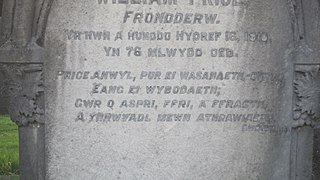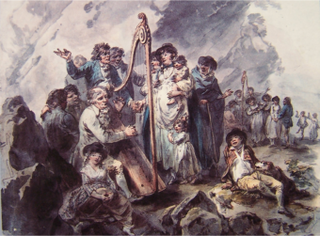
Dafydd ap Gwilym is regarded as one of the leading Welsh poets and amongst the great poets of Europe in the Middle Ages. Dafydd’s poetry also offers a unique window into the transcultural movement of cultural practices and preservation of culture in the face of occupation. Dafydd also helps answer questions that linger over the spread of culture. Even though it has been given less attention, cultural development in Wales differed slightly than in other parts of Europe during the same time.

In Welsh culture, an eisteddfod is an institution and festival with several ranked competitions, including in poetry and music. The term eisteddfod, which is formed from the Welsh morphemes: eistedd, meaning 'sit', and fod, meaning 'be', means, according to Hywel Teifi Edwards, "sitting-together." Edwards further defines the earliest form of the eisteddfod as a competitive meeting between bards and minstrels, in which the winner was chosen by a noble or royal patron.

Englyn is a traditional Welsh short poem form. It uses quantitative metres, involving the counting of syllables, and rigid patterns of rhyme and half rhyme. Each line contains a repeating pattern of consonants and accent known as cynghanedd.
In Welsh-language poetry, cynghanedd is the basic concept of sound-arrangement within one line, using stress, alliteration and rhyme. The various forms of cynghanedd show up in the definitions of all formal Welsh verse forms, such as the awdl and cerdd dafod. Though of ancient origin, cynghanedd and variations of it are still used today by many Welsh-language poets. A number of poets have experimented with using cynghanedd in English-language verse, for instance Gerard Manley Hopkins. Some of Dylan Thomas's work is also influenced by cynghanedd.
Welsh poetry refers to poetry of the Welsh people or nation. This includes poetry written in Welsh, poetry written in English by Welsh or Wales-based poets, poetry written in Wales in other languages or poetry by Welsh poets around the world.
Medieval Welsh literature is the literature written in the Welsh language during the Middle Ages. This includes material starting from the 5th century AD, when Welsh was in the process of becoming distinct from Common Brittonic, and continuing to the works of the 16th century.

Parts of the Bible have been translated into Welsh since at least the 15th century, but the most widely used translation of the Bible into Welsh for several centuries was the 1588 translation by William Morgan, Y Beibl cyssegr-lan sef Yr Hen Destament, a'r Newydd as revised in 1620. The Beibl Cymraeg Newydd was published in 1988 and revised in 2004. Beibl.net is a translation in colloquial Welsh which was completed in 2013.

Cerdd Dant is the art of vocal improvisation over a given melody in Welsh musical tradition. It is an important competition in eisteddfodau. The singer or (small) choir sings a counter melody over a harp melody.
Dafydd ab Edmwnd was one of the most prominent Welsh language poets of the Later Middle Ages.
Einion Offeiriad was a Welsh language poet and grammarian.
Dafydd Ddu o Hiraddug, also known as Dafydd Ddu Athro o Hiraddug, was a Welsh language poet, grammarian, and Roman Catholic priest in the diocese of Llanelwy. He was once believed to be the son of a certain Hywel ap Madog of Tremeirchion, but this has now been disproven.

Welsh-language literature has been produced continuously since the emergence of Welsh from Brythonic as a distinct language in around the 5th century AD. The earliest Welsh literature was poetry, which was extremely intricate in form from its earliest known examples, a tradition sustained today. Poetry was followed by the first British prose literature in the 11th century. Welsh-language literature has repeatedly played a major part in the self-assertion of Wales and its people. It continues to be held in the highest regard, as evidenced by the size and enthusiasm of the audiences attending the annual National Eisteddfod of Wales, probably the largest amateur arts festival in Europe, which crowns the literary prize winners in a dignified ceremony.
Bardic Grammar is a medieval Welsh grammar that provided bards with rules of writing poetry. Bards’ works celebrated heroic deeds of their patrons.
"The Poet's Burial for Love" or "The Poet's Burial" is a Welsh-language love poem in the form of a cywydd in which the poet foresees his own death from unrequited love. It was formerly attributed to the 14th-century Welsh poet Dafydd ap Gwilym, but in 1952 was rejected from the canon of his works by Dafydd's editor, Thomas Parry and is now widely considered to be a 15th-century poem of uncertain authorship. The poem has nevertheless remained very popular with translators and it continues to appear in anthologies, including Thomas Parry's own Oxford Book of Welsh Verse.

David Watkin Jones, also known by his bardic name Dafydd Morganwg, was a Welsh poet, historian and geologist. He is remembered as the author of numerous works, especially Yr Ysgol Farddol, considered by many later poets as the main text for Welsh prosody.
"The Poet and the Grey Friar" is a satirical poem in the form of a traethodl by the 14th-century Welsh poet Dafydd ap Gwilym, widely seen as the greatest of the Welsh-language poets. In it he relates an imaginary conversation with a Franciscan friar in which, rejecting the ascetic philosophy of the friar, he sets out a defence of love, poetry and the worldly life. It was included in The Oxford Book of Welsh Verse and The Penguin Book of Welsh Verse.
Gruffudd ap Maredudd ap Dafydd was a Welsh bard working in Anglesey in the service of the Tudors of Penmynydd. One of the last of the older school of poets known as the Gogynfeirdd, he resisted the innovations in Welsh verse-form which took place in his lifetime. About 2400 lines of his work have survived in the Red Book of Hergest. His best-known poem is "Gwenhwyfar", an elegy to a young lady. He was described by the literary historian D. Myrddin Lloyd as "the finest of all the late Gogynfeirdd poets" and by Saunders Lewis as "one of the greats".
Wiliam Llŷn was a Welsh-language poet whose work largely consists of elegies and praise-poems. He is considered the last major Welsh poet of the bardic tradition, comparable to the greatest late-medieval Welsh poets, and has been called Wales's supreme elegist. Two of his poems are included in The Oxford Book of Welsh Verse.

"The Magpie's Advice" or "The Magpie's Counsel" is a poem in the form of a cywydd by the pre-eminent Welsh-language poet, Dafydd ap Gwilym. The poet portrays himself as an overage lover who bemoans his romantic woes as he wanders through the woods, and is rebuked by a magpie who bids him concern himself with matters more befitting his years. It can be read either as a comic and self-mocking reversal of the traditional Welsh poetic trope of the non-human messenger, or llatai, being sent to the poet's lover, or as a meditation on the contrast between the yearly cycle of renewal in the natural world and the linear ageing of men, which falsifies any simplistic identification we may make with nature. It has always been one of Dafydd's more popular poems, surviving in 55 manuscripts and being widely translated in the 20th and 21st centuries. Sir Thomas Parry included it in his Oxford Book of Welsh Verse.